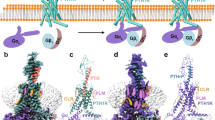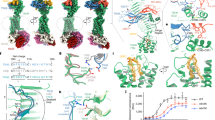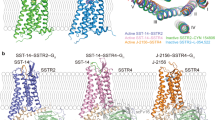Abstract
By combining evolutionary considerations, sequence comparisons and homology modeling we have designed recombinant human thyroid-stimulating hormone (hTSH) analogs with increased receptor binding and activity. The introduction of seven basic residues into the peripheral loops of hTSH resulted in up to a 50,000-fold increase in receptor binding affinity and 1300-fold increase in intrinsic activity. Such analogs are not only of potential clinical interest but can be tools to explore molecular aspects of conventional as well as nonclassical actions of glycoprotein hormones. These design strategies should be applicable to the development of novel analogs of other related hormones and growth factors with a variety of therapeutic and basic science applications, particularly for proteins that have undergone evolutionary decrease in bioactivity.
This is a preview of subscription content, access via your institution
Access options
Subscribe to this journal
Receive 12 print issues and online access
$209.00 per year
only $17.42 per issue
Buy this article
- Purchase on Springer Link
- Instant access to full article PDF
Prices may be subject to local taxes which are calculated during checkout
Similar content being viewed by others
References
Lowman, H.B. and Wells, J.A. 1993. Affinity maturation of human growth hormone by monovalent phage display. J. Mol. Biol. 234: 564–578.
Toniatti, C., Cabibbo, A., Sporena, E., Salvati, A.L., Cerretani, M., Serafini, S. et al. 1996. Engineering human interleukin-6 to obtain variants with strongly enhanced bioactivity. EMBO J. 15: 2726–2737.
Grossmann, M., Weintraub, B.D., and Szkudlinski, M.W. 1997. Novel insights into the molecular mechanisms of human thyrotropin action: structural, physiological and therapeutic implications for the glycoprotein hormone family. Endocr. Rev. 18: 476–501.
Lapthorn, A.J., Harris, D.C., Littlejohn, A., Lustbader, J.W., Canfield, R.E., Machin, K.J. et al. 1994. Crystal structure of human chorionic gonadotropin. Nature 369: 455–461.
Wu, H., Lustbader, J.W., Liu, Y., Canfield, R.E., and Hendrickson, W.A. 1994. Structure of human chorionic gonadotropin at 2.6 Å resolution from MAD analysis of the selenomethionyl protein. Structure 2: 545–558.
Keyt, B.A., Nguyen, H.V., Berleau, L.T., Duarte, C.M., Park, J., Chen, H. et al. 1996. Identification of vascular endothelial growth factor determinants for binding KDR and FLT-1 receptors. Generation of receptor-selective VEGF variants by site-directed mutagenesis. J. Biol. Chem. 271: 5638–5646.
Szkudlinski, M.W., Teh, N.G., Grossmann, M., Tropea, J.E., and Weintraub, B.D. 1996. Engineering human glycoprotein hormone superactive analogues. Nat. Biotechnol. 14: 1257–1263.
Pierce, J.G. and Parsons, T.F. 1981. Glycoprotein hormones: structure and function. Annu. Rev. Biochem. 50: 465–495.
Ferrara, N. and Davis-Smyth, T. 1997. The biology of vascular endothelial growth factor. Endocr. Rev. 18: 14–25.
Moyle, W.R., Campbell, R.K., Rao, S.N., Ayad, N.G., Bernard, M.P., Han, Y. et al. 1995. Model of human chorionic gonadotropin and lutropin receptor interaction that explains signal transduction of the glycoprotein hormones. J. Biol. Chem. 270: 20020–20031.
Moyle, W.R., Campbell, R.K., Myers, R.V., Bernard, M.P., Han, Y., and Wang, X. 1994. Co-evolution of ligand-receptor pairs. Nature 368: 251–255.
Grossmann, M., Szkudlinski, M.W., Wong, R., Dias, J.A., Ji, T.H., and Weintraub, B.D. 1997. Substitution of the seat-belt region of the thyrotropin (TSH)-β subunit with the corresponding regions of choriogonadotropin or foliitropin confers luteotropic, but not follitropic activity to chimeric TSH. J. Biol. Chem. 272: 15532–15540.
Fuh, G., Cunningham, B.C., Fukunaga, R., Nagata, S., Goeddel, D.V., and Wells, J.A. 1992. Rational design of potent antagonist to the human growth hormone receptor. Science 256: 1677–1680.
Kajava, A.V., Vassart, G., and Wodak, S.J. 1995. Modeling of the three-dimensional structure of proteins with the typical leucine-rich repeats. Structure 3: 867–877.
Bhowmick, N., Huang, J., Puett, D., Isaacs, N.W. and Lapthorn, A.J. 1996. Determination of residues important in hormone binding to the extracellular domain of the luteinizing hormone/chorionic gonadotropin receptor by site-directed mutagenesis and modeling. Mol. Endocrinol. 10: 1147–1159.
Schreiber, G. and Fersht, A.R., 1996. Rapid, electrostatically assisted association of proteins. Nat. Struct. Biol. 3: 427–431.
Wang, Y., Shen, B.J., and Sebald, W. 1997. A mixed-charge pair in human inter-leukin-4 dominates high-affinity interaction with the receptor alpha chain. Proc. Natl. Acad. Sci. USA 94: 1657–1662.
Hebert, T.E., Moffett, S., Morello, J.P., Loisel, T.P., Bichet, D.G., Barret, C. et al. 1996. A peptide derived from a beta2-adrenergic receptor transmembrane domain inhibits both receptor dimerization and activation. J. Biol. Chem. 271: 16384–1692.
Vassart, G., Van Sande, J., Parma, J., Tonacchera, M., Duprez, L., Swillen, S. et al. 1996. Activating mutations of the TSH receptor gene cause thyroid diseases. Ann. Endocrinol. 57: 50–54.
Wang, J., Whetsell, M., and Klein, J.R. 1997. Local hormone networks and intestinal T cell homeostasis. Science 275: 1937–1939.
Grossmann, M., Szkudlinski, M.W., Tropea, J.E., Bishop, L.A., Thotakura, N.R., Schofield, P.R. et al. 1995. Expression of human thyrotropin cell lines with different glycosylation patterns combined with mutagenesis of specific glycosylation sites. Characterization of a novel role for the oligosaccharides in the in vitro and in vivo bioactivity. J. Biol. Chem. 270: 29378–29385.
Grossmann, M., Szkudlinski, M.W., Zeng, H., Kraiem, Z., Ji, I., Tropea, J.E. et al. 1995. Role of the carboxy-terminal residues of the alpha-subunit in the expression and bioactivity of human thyroid-stimulating hormone. Mol. Endocrinol. 9: 948–958.
Perret, J., Ludgate, M., Libert, F., Gerard, C., Dumont, J.E., Vassart, G. et al. 1990. Stable expression of the human TSH receptor in CHO cells and characterization of differentially expressing clones. Biochem. Biophys. Res. Commun. 171: 1044–1050.
Szkudlinski, M.W., Grossmann, M., and Weintraub, B.D. 1997. Progress in understanding structure-function relationships of human thyroid-stimulating hormone. Current Opinion in Endocrinology and Diabetes 4: 354–363.
Author information
Authors and Affiliations
Rights and permissions
About this article
Cite this article
Grossmann, M., Leitolf, H., Weintraub, B. et al. A rational design strategy for protein hormone superagonists. Nat Biotechnol 16, 871–875 (1998). https://doi.org/10.1038/nbt0998-871
Received:
Accepted:
Published:
Issue Date:
DOI: https://doi.org/10.1038/nbt0998-871
This article is cited by
-
Single chain human chorionic gonadotropin, hCGαβ: Effects of mutations in the α subunit on structure and bioactivity
Glycoconjugate Journal (2006)
-
Integrating cell-level kinetic modeling into the design of engineered protein therapeutics
Nature Biotechnology (2005)



